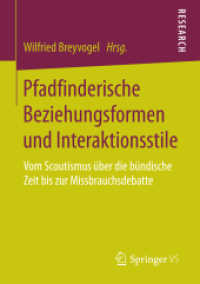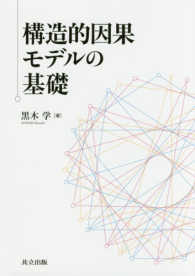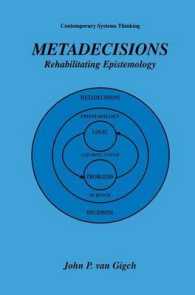- ホーム
- > 洋書
- > 英文書
- > History / World
Full Description
In The Culture of Love in China and Europe Paolo Santangelo and Gabor Boros offer a survey of the cults of love developed in the history of ideas and literary production in China and Europe between the 12th and early 19th century. They describe parallel evolutions within the two cultures, and how innovatively these independent civilisations developed their own categories and myths to explain, exalt but also control the emotions of love and their behavioural expressions. The analyses contain rich materials for comparison, point out the universal and specific elements in each culture, and hint at differences and resemblances, without ignoring the peculiar beauty and attractive force of the texts cultivating love.
Contents
Authors' PrefaceList of FiguresPart 1: ChinaPaolo SantangeloIntroductory Notes1 Emotions and Love. Philosophical Representation of Passions: Emotions and Human Nature in Neo-Confucian ThoughtBasic Terms and Notions Concerning the Idea of "Love"Chinese Notions Ascribable to the Concepts of LovePassions and Love Passion (Qing)Qing: a Short Historical Survey The "Romantics" in the Medieval PeriodThe Cosmologists. The Concept of Psychophysical Nature and the Principle-Desires Scheme in the School of PrinciplesWang YangmingRehabilitation of Emotions and Desires. Ideological Basis for a Cult of PassionsDevelopments of the Schools of MindFrom Ming to QingThe Cult of Passions during the Qing DynastyTwo Main Trends and Domestication of Passions2 Various Facets of Love in Literary SourcesThe So-Called Cult of Passions in Literary WorksThe 'True Emotions' and 'True Love'Love Winning Death: Mythical and Supernatural ElementsThe "Mutual Love Tree"Destiny and Predestined LoveTwo Treatises on Love: the "History of Love" (Qingshi leilue ) and De AmoreIn Search of a New MoralityLove, Desire and LustSeduction: Breaches, Temptations and LonelinessThe Rhetoric of Gendered SeductionBody and Beauty: the Language of Body as Seductive LanguageLove-Affection as Moral Sentiment: Conjugal Love and Its AntagonistsGender's Roles in Love. New and Old Images of Heroines and HeroesFemme fataleIllicit and Practical Loves. Love as a FoodThe Dark and Surreal Sides of Love. Eros and DeathPassions are Like Dreams. Between Social Limitations and Dream Freedom3 Concluding Remarks and Bibliography to Part 1Concluding RemarksBibliography to Part 1Part 2: EuropeGabor Boros4 European Philosophies of Love - General IntroductionPreface1 Historical Introduction2 Philosophical Introduction - Sources, Ideas, Terminology5 The Scholastic Period1 Love of God According to Bernard of Clairvaux2 Peter Abelard's Calamities of Love3 Andreas Capellanus and Love's Labours in His On Love4 Thomas Aquinas' Systematised Christian Concept of Love5 Facets of Love in Literary Sources: Courtly Love6 Christian and Jewish, Florentine and Neapolitan Versions of Neoplatonism1 Marsilio Ficino's Commentaries on Plato's Texts on Love2 Giovanni Pico della Mirandola: a Platonic Discourse on Love - in Exposition of a Sonnet by Girolamo Benivieni3 Leone Ebreo's Dialogues of Love4 The Dissolution of the Christian-Platonic Tradition of Love: Castiglione, Bruno5 Facets of Love in Literary Sources: 14th-17th Century7 Concepts of Love in the 17th Century1 Concepts of Love in the Early 17th Century Religious Renovation and in the Passage from Traditional Physiology to the Mechanical Science-based Medicine (Jacques Ferrand, and Francis of Sales, Fenelon and Mme Guyon)2 Metaphysic-based Concepts of Love in the 17th Century8 Enlightenments: Naturalizing Concepts of Love1 Hume's Philosophy of Love: Sympathy Based on Experimental Natural Law2 French Enlightenment3 Kant's Concepts of Love, Marriage and Friendship from Traditional Natural Law Perspective9 The Beginnings of Romanticism1 Facets of Love in Literary Sources: Schlegel's and Goethe's Respective Versions of Romantic Concepts of Love2 Hegel and the Impossibility to Find a Place for Love within the Rational State3 Facets of Love in Literary Sources: Stendhal On Love4 Kierkegaard's Ultimate Concept of Love in His The Works of LoveBibliography to Part 2ConclusionIndex








